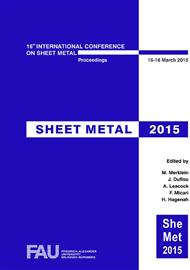[1]
D. Li, P. Hu, Y. Cao, J. Wang: Section analysis of industrial sheet-metal stamping processes. In: Journal of Materials Processing Technology 120, 2002, pp.37-44.
DOI: 10.1016/s0924-0136(01)01040-8
Google Scholar
[2]
A.V. Rao, N. Ramakrishnan, R.K. Kumar: A comparative evaluation of the theoretical failure criteria for workability in cold forging. In: Journal of Materials Processing Technology 140, 2003, pp.29-42.
DOI: 10.1016/s0924-0136(03)00432-1
Google Scholar
[3]
A.M. Freudenthal: Safety and the Probability of Structural Failure. In: American Society of Civil Engineers Transactions 121, 1956, pp.1337-1397.
DOI: 10.1061/taceat.0007306
Google Scholar
[4]
M.G. Cockroft, D.J. Latham: Ductility and the workability of metals. In: Journal of the Institute of Metals 96, 1968, pp.33-39.
Google Scholar
[5]
P. Brozzo, B. DeLuca, R. Rendina: A new method for the prediction of formability limits in metal sheets, sheet metal forming and formability. In: Proceedings of the Seventh Biennial Conference of the International Deep Drawing Research Group, Amsterdam, Netherlands, 1972: pp.9-13.
Google Scholar
[6]
S.I. Oh, C.C. Chen, S. Kobayashi: Ductile Fracture in Axisymmetric Extrusion and Drawing—Part 2: Workability in Extrusion and Drawing. In: Journal of Manufacturing Science and Engineering 101, 1979, pp.36-44.
DOI: 10.1115/1.3439471
Google Scholar
[7]
D.M. Norris, J.E. Reaugh, B. Moran, D.F. Quinnones: A plastic-strain, mean-stress criterion for ductile fracture. In: Journal of Engineering Materials and Technology 100, 1978, pp.279-286.
DOI: 10.1115/1.3443491
Google Scholar
[8]
Y.K. Ko, J.S. Lee, H. Huh, H.K. Kim, S.H. Park: Prediction of fracture in hub-hole expanding process using a new ductile fracture criterion. In: Journal of Materials Processing Technology 187-188, 2007, pp.358-362.
DOI: 10.1016/j.jmatprotec.2006.11.071
Google Scholar
[9]
V. Vujovic, A. Shabaik: A new workability criterion for ductile materials. In: Journal of Engineering Materials and Technology 108, 1986, pp.245-249.
DOI: 10.1115/1.3225876
Google Scholar
[10]
A.S. Argon, J. Im, R. Safoglu: Cavity Formation from Inclusions Inductile Fracture. In: Metallurgical Transactions A 6, 1975, pp.825-837.
DOI: 10.1007/bf02672306
Google Scholar
[11]
M. He, F. Li, Z. Wang: Forming limit stress diagram prediction of aluminum alloy 5052 based on GTN model parameters determined by in situ tensile test. In: Chinese Journal of Aeronautics 24, 2011, pp.378-386.
DOI: 10.1016/s1000-9361(11)60045-9
Google Scholar
[12]
F.A. McClintock: A criterion for ductile fracture by the growth of holes. In: Journal of Applied Mechanics 35, 1968, pp.363-371.
DOI: 10.1115/1.3601204
Google Scholar
[13]
J.R. Rice, D. Tracey: On the ductile enlargement of voids in triaxial stress fields. In: Journal of the Mechanics and Physics of Solids 17, 1969, pp.201-217.
DOI: 10.1016/0022-5096(69)90033-7
Google Scholar
[14]
A.L. Gurson: Continuum Theory of Ductile Rupture by Void Nucleation and Growth—Part 1: Yield criteria and flow rules for porous ductile media. In: Journal of Engineering Materials and Technology-Transactions of the ASME, 99, 1977, pp.2-15.
DOI: 10.1115/1.3443401
Google Scholar
[15]
V. Tvergaard: Influence of voids on shear and instabilities under plane strain conditions. In: International Journal of Fracture, 17, 1981, pp.389-407.
DOI: 10.1007/bf00036191
Google Scholar
[16]
A. Needleman, V. Tvergaard: An analysis of ductile rupture in notched bars. In: Journal of the Mechanics and Physics of Solids 32, 1984, pp.461-490.
DOI: 10.1016/0022-5096(84)90031-0
Google Scholar
[17]
J. Lemaitre: A Continuous Damage Mechanics Model for Ductile Fracture. In: Journal of Engineering Materials and Technology 107, 1985, pp.83-89.
DOI: 10.1115/1.3225775
Google Scholar


